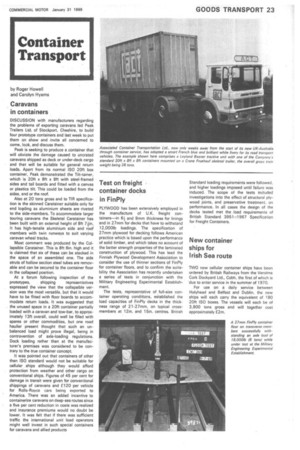by Roger Howell and Carolyn Hyams
Page 25

If you've noticed an error in this article please click here to report it so we can fix it.
Caravans in containers
DISCUSSION with manufacturers regarding the problems of exporting caravans led Peak Trailers Ltd. of Stockport. Cheshire, to build. four prototype containers and last week to put them on show and invite all concerned to come, look, and discuss them.
Peak is seeking to produce a .container that will obviate the damage caused to uncrated caravans shipped as deck or under-deck cargo and that will be suitable for general return loads. Apart from its normal ISO 20ft box container, Peak demonstrated the Tilt-tainer, which is 20ft x 8ft x 8.11 with steel-framed sides and tail boards and fitted with a canvas or plastics tilt. This could be loaded from the sides, end or the roof.
Also at 20 tons gross and to TIR specification is the skinned Caratainer suitable only for end loading as aluminium sheets are riveted to the side-members. To accommodate larger touring caravans the Skeletal Caratainer has been built with an external height of 8ft 74in. It has high-tensile aluminium side and roof members with twin runways to suit varying caravan wheel tracks.
Most comment was produced by the Collapsible Caratainer. This is 8ft 6in. high and it is claimed that six of these can be stacked in the space of an assembled one. The side struts of hollow section steel tubes are removable and can be secured to the container floor in the collapsed position.
At a forum following inspection of the prototypes, shipping representatives expressed the view that the collapsible version was the most versatile, but that it would have to be fitted with floor boards to accommodate return loads. It was suggested that the unused space in a 20ft container partially loaded with a caravan and tow-bar, to approximately 13ft overall, could well be filled with spares or other commodities, but one road haulier present thought that sUch an unbalanced load might prove illegal, being in contravention of axle-loading regulations. Dock loading rather than at the manufacturers premises was considered to be contrary to the true container concept.
It was pointed out that containers of other than ISO standard would not be suitable for cellular ships although they : would afford protection from weather and other cargo on conventional ships. Figures of 45 per cent for damage in transit were given for conventional shippings of caravans and £120 per vehicle for Rolls-Royce cars being exported to America. There was an added incentive to containerize caravans on deep-sea routes since a five per cent reduction in costs was realized and insurance premiums would no doubt be lower. It was felt that if there was sufficient traffic the international unit load operators might well invest in such special containers for caravans and allied products




































































































